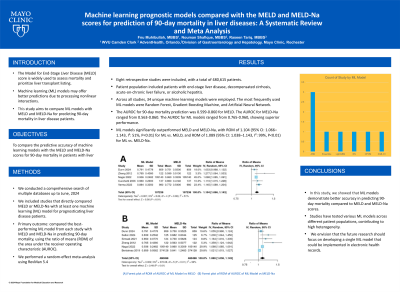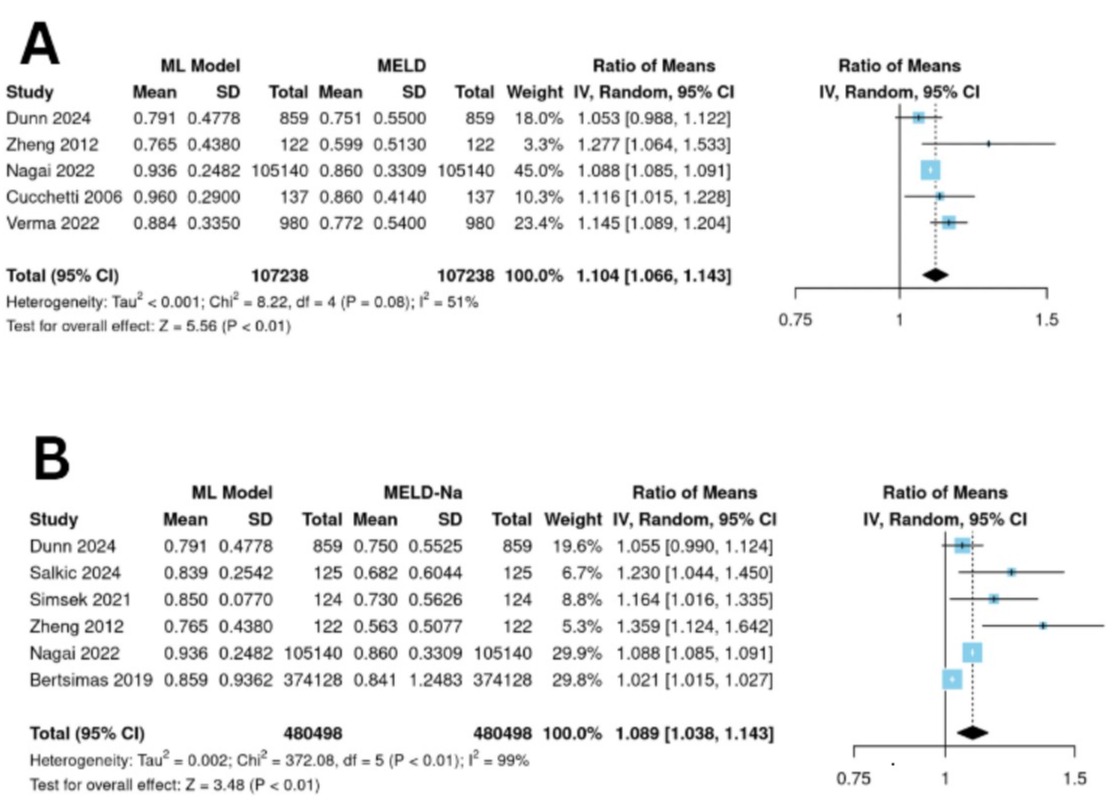Sunday Poster Session
Category: Liver
P1166 - Machine Learning Prognostic Models Compared With the MELD and MELD-Na Scores for Prediction of 90-Day Mortality in Liver Diseases: A Systematic Review and Meta-Analysis
Sunday, October 27, 2024
3:30 PM - 7:00 PM ET
Location: Exhibit Hall E


Raseen Tariq, MBBS
Mayo Clinic
Rochester, MN
Presenting Author(s)
Fnu Muhibullah, MD, MBBS1, Nouman Shafique, MD2, Raseen Tariq, MBBS3
1West Virginia University Camden Clark Medical Center, Parkersburg, WV; 2AdventHealth, Orlando, FL; 3Mayo Clinic, Rochester, MN
Introduction: The Model for End-Stage Liver Disease (MELD) score has been widely used as a tool to assess mortality and for liver transplant listing. Several variants of the MELD score have been adopted, including the Model for End-Stage Liver Disease-Sodium (MELD-Na) and MELD 3.0. Machine learning (ML) models are expected to perform better than conventional prognostic scores due to their superior ability to process nonlinear interactions. This systematic review and meta-analysis aims to compare ML models with the MELD and MELD-Na scores for prediction of 90-day mortality in patients with liver diseases.
Methods: We conducted a comprehensive search of various databases from their inception to June 8, 2024. We included studies with a head-to-head comparison of MELD or MELD-Na with at least one ML model for the prognosis of patients with liver diseases. The primary outcomes were a comparison of the best performing ML models with MELD and MELD-Na in their ability to successfully predict mortality at 90 days. The comparison was done using the ratio of means (ROM) of the area under the receiver operating characteristic curve (AUROC). A random effect meta-analysis was performed using RevMan 5.4.
Results: Eight full-text retrospective studies with 480,615 patients were included. The patient population included patients with end-stage liver disease, decompensated cirrhosis, acute-on-chronic liver failure, and alcoholic hepatitis. A total of 34 unique models were used in the included studies. Most commonly employed ML models were Random Forest, Gradient Boosting Machine and Artificial Neural Network (Table). The AUROC for 90-day mortality ranged from 0.599-0.860 for MELD, 0.563-0.860 for MELD-Na, and 0.765-0.960 for ML models. ML models significantly outperformed both MELD and MELD-Na for the prediction of mortality at 90 days, with ROM for ML models versus MELD 1.104 (95% CI: 1.066–1.143), I2: 51%, P< 0.01 and ROM for ML models versus MELD-Na 1.089 (95% CI: 1.038–1.143, I2:99%, P< 0.01) (Figure).
Discussion: ML models seem to have better performance predicting 90-day mortality as compared to both MELD and MELD-Na scores. However, studies have focused on multiple ML models and tested them with different populations, leading to high heterogeneity. Future research should focus on developing a single ML model that could be implemented in electronic health records.

Note: The table for this abstract can be viewed in the ePoster Gallery section of the ACG 2024 ePoster Site or in The American Journal of Gastroenterology's abstract supplement issue, both of which will be available starting October 27, 2024.
Disclosures:
Fnu Muhibullah, MD, MBBS1, Nouman Shafique, MD2, Raseen Tariq, MBBS3. P1166 - Machine Learning Prognostic Models Compared With the MELD and MELD-Na Scores for Prediction of 90-Day Mortality in Liver Diseases: A Systematic Review and Meta-Analysis, ACG 2024 Annual Scientific Meeting Abstracts. Philadelphia, PA: American College of Gastroenterology.
1West Virginia University Camden Clark Medical Center, Parkersburg, WV; 2AdventHealth, Orlando, FL; 3Mayo Clinic, Rochester, MN
Introduction: The Model for End-Stage Liver Disease (MELD) score has been widely used as a tool to assess mortality and for liver transplant listing. Several variants of the MELD score have been adopted, including the Model for End-Stage Liver Disease-Sodium (MELD-Na) and MELD 3.0. Machine learning (ML) models are expected to perform better than conventional prognostic scores due to their superior ability to process nonlinear interactions. This systematic review and meta-analysis aims to compare ML models with the MELD and MELD-Na scores for prediction of 90-day mortality in patients with liver diseases.
Methods: We conducted a comprehensive search of various databases from their inception to June 8, 2024. We included studies with a head-to-head comparison of MELD or MELD-Na with at least one ML model for the prognosis of patients with liver diseases. The primary outcomes were a comparison of the best performing ML models with MELD and MELD-Na in their ability to successfully predict mortality at 90 days. The comparison was done using the ratio of means (ROM) of the area under the receiver operating characteristic curve (AUROC). A random effect meta-analysis was performed using RevMan 5.4.
Results: Eight full-text retrospective studies with 480,615 patients were included. The patient population included patients with end-stage liver disease, decompensated cirrhosis, acute-on-chronic liver failure, and alcoholic hepatitis. A total of 34 unique models were used in the included studies. Most commonly employed ML models were Random Forest, Gradient Boosting Machine and Artificial Neural Network (Table). The AUROC for 90-day mortality ranged from 0.599-0.860 for MELD, 0.563-0.860 for MELD-Na, and 0.765-0.960 for ML models. ML models significantly outperformed both MELD and MELD-Na for the prediction of mortality at 90 days, with ROM for ML models versus MELD 1.104 (95% CI: 1.066–1.143), I2: 51%, P< 0.01 and ROM for ML models versus MELD-Na 1.089 (95% CI: 1.038–1.143, I2:99%, P< 0.01) (Figure).
Discussion: ML models seem to have better performance predicting 90-day mortality as compared to both MELD and MELD-Na scores. However, studies have focused on multiple ML models and tested them with different populations, leading to high heterogeneity. Future research should focus on developing a single ML model that could be implemented in electronic health records.

Figure: Figure: (A) Forest plot of ROM of AUROC of ML Model vs MELD (B) Forest plot of ROM of AUROC of ML Model vs MELD-Na
Note: The table for this abstract can be viewed in the ePoster Gallery section of the ACG 2024 ePoster Site or in The American Journal of Gastroenterology's abstract supplement issue, both of which will be available starting October 27, 2024.
Disclosures:
Fnu Muhibullah indicated no relevant financial relationships.
Nouman Shafique indicated no relevant financial relationships.
Raseen Tariq indicated no relevant financial relationships.
Fnu Muhibullah, MD, MBBS1, Nouman Shafique, MD2, Raseen Tariq, MBBS3. P1166 - Machine Learning Prognostic Models Compared With the MELD and MELD-Na Scores for Prediction of 90-Day Mortality in Liver Diseases: A Systematic Review and Meta-Analysis, ACG 2024 Annual Scientific Meeting Abstracts. Philadelphia, PA: American College of Gastroenterology.
